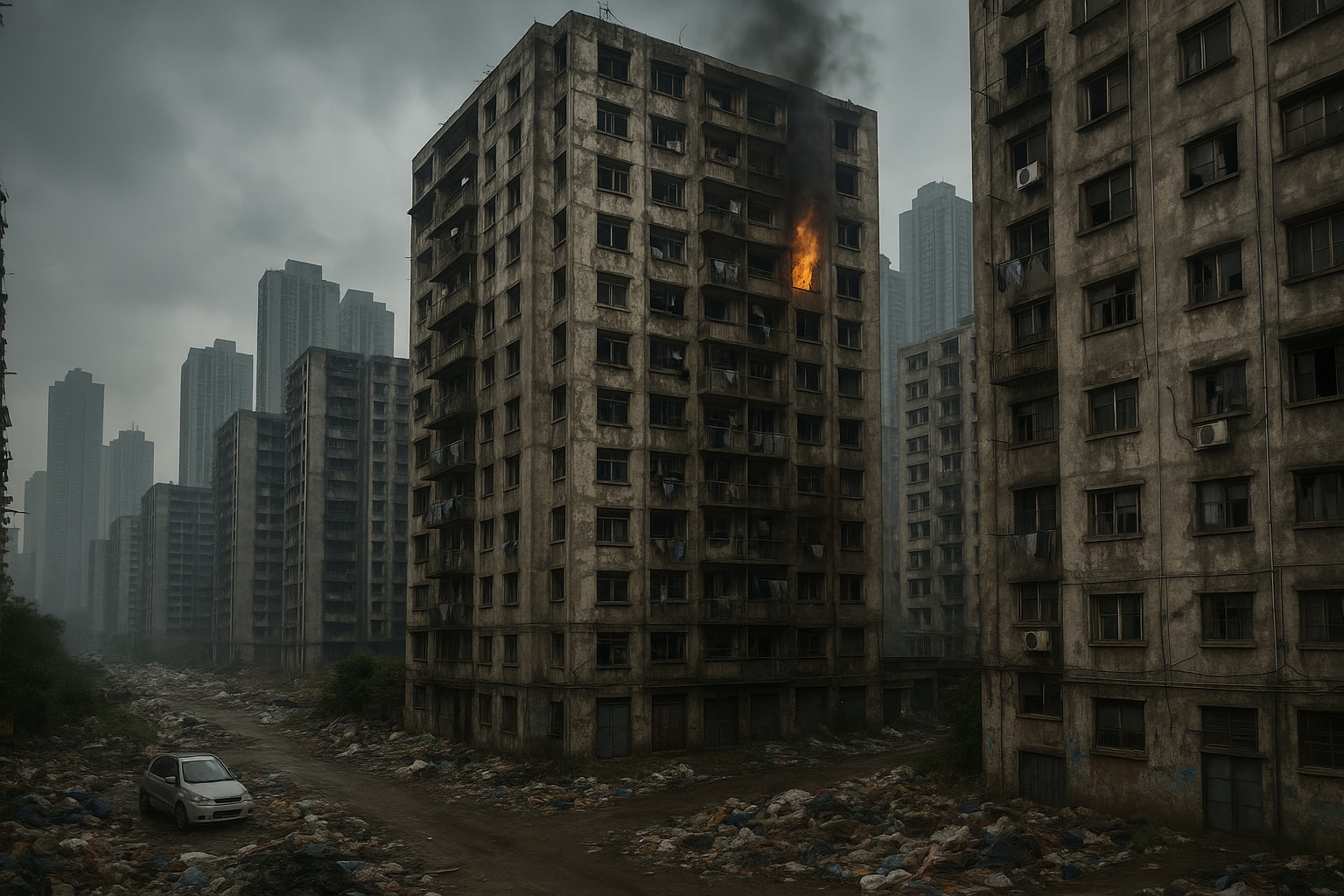China’s Urban Planning Disaster—High-Rises Becoming Unsafe Slums

China’s megacities have seen an explosion of high-rise developments, transforming their skylines with towering apartment blocks designed to accommodate millions. Yet, these ambitious projects are unravelling, revealing structural flaws and skyrocketing maintenance costs. Once symbols of modern urban living, many buildings are deteriorating rapidly, losing market value and trapping residents in declining neighbourhoods. The dream of high-rise prosperity is fading, leaving homeowners stranded in unsafe, decaying environments with no realistic escape.
The structural integrity of many high-rise buildings is dangerously compromised, often resembling fragile “tofu-like” construction. These skyscrapers present serious risks, with weak frameworks threatening residents’ safety. Data from mid-2024 indicates that more than 30,000 high-rise fires have occurred nationwide in the past decade. Firefighting efforts are severely hindered above the 30th floor, leaving those living at extreme heights with limited escape options, making fires potentially catastrophic.
Elevator failures also pose a significant threat. High-rise buildings depend on elevators, yet many experience frequent breakdowns due to overloading, aging components, and poor maintenance. Beyond mere inconvenience, these malfunctions can be fatal, as elevator-related incidents constitute a major urban safety concern.
Concerns have been raised about the aging phase of China’s earliest super high-rise buildings, particularly those exceeding 40 stories. Like any structure, these towers undergo a natural life cycle, and as they age, the risks associated with deterioration become increasingly apparent. Signs of wear begin to surface—elevators malfunction frequently, water seeps into walls, paint peels, and electrical systems falter. For residents living on higher floors, even routine maintenance becomes a daunting task.
High-rise buildings constructed during the 1980s and 1990s are already showing significant decline, creating uncomfortable living conditions while posing hidden risks that intensify over time. A growing concern is the question of responsibility—once these buildings reach a critical state, determining who should oversee repairs becomes a complicated issue. Developers move on after selling the units, while maintenance costs climb steeply. Demolition remains an impractical solution due to high expenses, leaving many aging towers to deteriorate with no clear resolution in sight.
Many homeowners remain stuck in deteriorating high-rise apartments with no way out. One blogger shared their frustration, recalling how their 63rd-floor unit, once valued at 4.5 million yuan ($620,000), was listed at 4.19 million in 2020. By 2025, even with a reduced price of 3 million yuan, no buyers showed interest. The inability to sell these properties results in heavy financial losses, leaving owners burdened with assets they can no longer market. As population numbers decline and the real estate sector continues to weaken, selling an aging high-rise apartment becomes nearly impossible.
Beyond the financial burden, high-rise living presents daily challenges that many residents come to regret. A high-rise building expert cautions against purchasing high-rise homes, highlighting several frustrating issues that disrupt everyday life.
Noise pollution is a constant concern, as sounds from neighbours, children playing, and footsteps reverberate through thin walls, making peace and quiet hard to come by. Elevator congestion during peak hours turns morning commutes into an ordeal, with residents often waiting at least ten minutes just to reach the ground floor. Mobile reception is noticeably weaker on higher floors, making even simple phone calls an unnecessary struggle.
Water and heating systems also pose problems, with low water pressure during peak hours sometimes causing a complete halt in flow. Winters bring inadequate heating, forcing residents to rely on costly electric alternatives. Frequent power outages add to the difficulties, further disrupting daily routines. Extreme weather makes matters worse, as storms cause buildings to sway alarmingly, while thunder feels unsettlingly close, instilling fear among residents.
Although Chinese high-rise buildings are theoretically designed to last for half a century, structural problems often emerge within the first 25 years. Complaints about peeling walls, burst pipes, outdated wiring, and malfunctioning elevators become common as the buildings age. Addressing these issues proves to be extremely costly, and maintenance funds within communities frequently fall short. For homeowners looking to sell, options remain limited, as older high-rise apartments gradually lose their market appeal.
Concerns have been raised about the initial construction approach, which prioritized short-term profits over long-term sustainability. Developers focused on maximizing land use without considering future renovation needs, leaving these towering structures vulnerable to decline. Over time, they risk becoming neglected remnants of a housing boom that failed to account for durability and adaptability.
What was once promoted as a modern housing revolution is now exposing deep flaws in China’s urban planning strategies. The push for rapid high-rise development, encouraged by policymakers and the Chinese Communist Party, prioritized economic expansion and urban density over long-term sustainability. Weak regulatory oversight, coupled with developers’ profit-driven motives, resulted in poorly constructed, high-maintenance buildings that quickly deteriorate. With no clear policies for renovation or demolition, these structures risk becoming dangerous slums. The failure to ensure quality housing raises critical questions about accountability and the future of China’s urban communities.




![From Kathmandu to the World: How Excel Students Are Winning Big [Admission Open]](https://nepalaaja.com/index.php/img/70194/medium/excel-college-info-eng-nep-2342.jpg)
